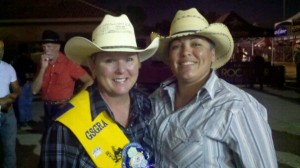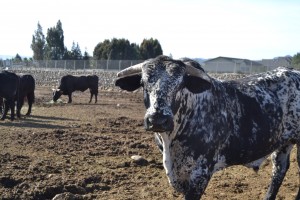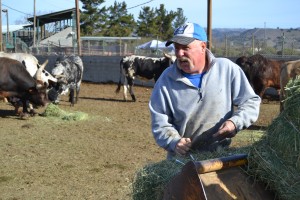
To flip a 700-pound cow off its feet and onto the ground, start with the mouth. Find the space between its teeth, on the rubbery, wet gums, and hook your fingers inside. Or go for a headlock. Or wedge a hip into the soft space between its neck and shoulder.
Deanna Trujillo-James recommends trying it all.
She has four pairs of hats, five pairs of boots, good luck jeans and good luck shirts. On weekends, she will drive from her home in Oakland to a beaten-up rodeo ground off the highway in Morgan Hill, sign a waiver, and tussle with cattle for hours. At parties, when people ask her hobbies, she tells them, “I wrestle steers.”
Trujillo-James is one of hundreds of amateur contestants who, every February through October, suit up for the gay rodeo circuit, a series of local rodeo competitions that span gay communities across the nation, including an arena near the famed Las Vegas Strip and the state fairgrounds in Oklahoma City.
Over the course of eight months, competitors work to collect enough points to get the coveted letter in the mail, inviting them to October’s World Gay Rodeo Finals in Fort Worth, Texas. There, the champions walk away with prize money, bragging rights and a collection of the wide, shiny belt buckles that mark rodeo elite in any league. The spectators cheer and party.
“To compete there,” Trujillo-James said, “takes your breath away.”

Such moments of grace aren’t common in the sport. Rodeo is an often muddy, sweaty competition, where chutes clang open, competitors thud into paddock dirt, and cattle and horses throw kicks that can break riders’ bones.
But it is also a historic American pursuit, a mix of Spanish and Mexican horsemanship and the frontier skills of the American cowboy — roping, riding, herding. Today, rodeo grounds span the United States and the prairie provinces of Canada.
Traditionally a sport of cattle towns, rodeo is both growing and opening up. Within the United States, gay, Native American, black, Hispanic, and Hawaiian groups all host rodeos.
Gay rodeo is a smaller, amateur version of the big-money professional rodeo circuit, but with a more pronounced mission. It had humble beginnings in 1975, when the gay community in Reno wanted to throw a rodeo for charity but struggled to find a local rancher who would rent livestock for a gay event.
Out of that first assortment of five cows, a pig and a pony, gay rodeo has become a complex enterprise. This year, 12 states and Canada will host gay rodeos, and “Queens and Cowboys,” an independent documentary about the circuit, is raising awareness of the sport on the film festival circuit. In keeping with tradition, many rodeos still raise money for charity.
Like a lot of competitors, Trujillo-James did not grow up watching cowboys bucking bulls. She was a studious kid in Southern California, raised by a single mother with a big extended family. When her family discovered she was dating a woman, she and her mother stopped speaking.
Judy James is Trujillo-James’ wife, and a gay rodeo promoter. Her father would take her to rodeos in his native Wyoming every year. Like Trujillo-James, coming out was a trial for James. She ran away from home at 17, after her parents found her love letters to another woman. She was legally emancipated from her family just before turning 18, after a family intervention went bad and her father ended up pointing a gun at her, James said.
But rodeo was a bond in both families.
On their last visit to see James’ father before he died, they took him out to the same rodeo she had visited as a child.
“The greatest joy in my life is that father got to meet Dee, and accepted her,” James said.

Trujillo-James’ mother now regales friends with stories about her cowgirl daughter. For years, she had hoped her daughter’s interest in women was “just a phase,” but now discusses gay rodeo with pride.
“She tells people, ‘My daughter’s a gay cowgirl.’ She loves educating people,” Trujillo-James said.
What sets gay rodeo apart from other rodeo leagues is its resolutely amateur nature.
“We have a lot of competitors — straight and gay — who choose our rodeo because they are going to get challenged off some pretty good livestock, but not as much as the mainstream rodeo where the livestock are just going to knock you out,” Judy James said.
Also, gay rodeo is gender-neutral, allowing men and women to compete equally in events. While women are often restricted to barrel racing or other non-contact events in traditional rodeo, women competitors in gay rodeos can bull ride, bareback ride and wrestle steers.
Gay rodeo incorporates the traditional events found in any rodeo, like riding and roping, with decidedly non-traditional ones: putting panties on a goat, or helping a drag queen ride a bull.
“There are things you’re just not going to find anywhere but a gay rodeo,” Trujillo-James said.
Unlike the pro leagues, no one is going to make a living off gay rodeo. Competitors often pay nearly as much in entry fees as they will make in prize money, sometimes more than $100 per weekend for a $250 prize. But Judy James says the finances are beside the point. Instead, it’s an opportunity — even outside the arena — to be a part of a deeper culture.
“It’s like a Batman lifestyle,” she said. “This is who we are. I may not wear a cowboy hat here, but it’s still a part of me.”
Even in San Francisco’s Castro District, an epicenter for gay fashion and culture, a cowboy hat and a pair of boots turns heads. Within the Bay Area’s gay community, rodeo competitors are a small, tight-knit group.
Dressed in their full Western outfits, they sometimes become objects of fascination on nights out. “It’s a reversal. Now we’re the grand dames of the ball because there are eight of us in a room full of hundreds of drag queens,” Trujillo-James said.

In the small towns in the Bay Area where they sometimes compete — like the mountain town of La Honda in San Mateo County — the reaction is similar. “When we show up, people shout, ‘Gay cowboys are here!’ We bring in a lot of business to these small communities,” she said.
But the rodeo world is changing around them.
Bill Lyle is an old hand at the sport; he rode his first bull at 14 and aches from old competition injuries. Today, he runs the rodeo grounds where Trujillo-James trains in Morgan Hill, and supplies bulls for gay and traditional rodeos.
Lyle has seen rodeo wax and wane in popularity. Its peak saw riders seduced by movies such as “Urban Cowboy” in 1980, he said, but the Professional Bull Riders craze has swept a lot of interest away from the traditional competition. Now, when he hosts a rodeo, it’s usually in Spanish.
Both he and rodeo promoter KC Andersen worry about the future of the sport in a rapidly urbanizing Bay Area. Andersen said the rodeo world tends to stick together, though, and that bodes well for the sport’s longevity.
“Gay rodeos, black rodeos, Hispanic rodeos, we all support each other,” she said. “We’re all trying to keep the heritage going.”
Judy James agrees, but is optimistic for the future of the sport: “We have competitors who have children, who are teenagers now and are getting ready to start competing. It’s what they know. It’s the way it should be.”
